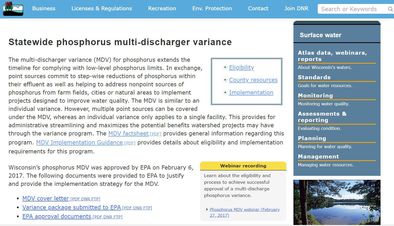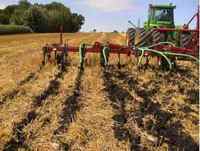 If a county wishes to particpate in the MDV, they must signup by January 1, 2019.
The Multiple Discharger Variance for phosphorus, or MDV, is a means to extend the timeline in which an eligible facility can install treatment upgrades or engage in watershed-based compliance options such as water quality trading or adaptive management. To date, 65 facilities statewide have been approved for an MDV. If facilities choose the "County Option", the facilities agree to make payments to counties within their basin to implement practices aimed at reducing phosphorus runoff. However, counties are free to choose whether or not they participate. The amount paid is based on the annual mass of phosphorus discharged from the facility ($50/lb+inflation), and payments are distributed to PARTICIPATING counties based on the percentage of the basin (HUC 8) that each participating county represents. The deadline for counties to decide if they wish to participate is January 1st.
- Complete, sign, and submit the MDV Participation Form (Form # 3200-146),
- Identify which HUC 8 Watershed(s) you would like to participate in,
- The only required answer in the Yes/No section is YES: “The County is eligible to receive funds generated from the MDV. By receiving these funds the County commits to submit a watershed plan on March 1st of the next calendar year and complete an annual report to the Department no later than May 1st of the second year after receiving a payment”
- Mail the signed application to: Wisconsin Department of Natural Resources Permits Section-WQ/3, Attn: MDV Point Source Coordinator PO Box 7921 Madison, WI 53707-7921
Or email the signed application to: matthew.claucherty@wisconsin.gov
How much money is available?: Roughly $750,000 is available to counties for the 2018 calendar year. Estimates have been compiled for each county, based on past discharge data from each MDV facility. These are only estimates and may change based on effluent phosphorus levels.
What can I expect next? You will receive an email confirming receipt of your form, along with a list of your facilities and projected payments from each. Since payments are based on all 2018 discharge data, exact numbers will not be available until late January. At that point, DNR will be running the numbers, invoicing facilities, and providing these numbers to participating counties in early February. Payments from facilities should arrive in early March, 2019.

In Dane County, multiple conservation partners worked together to restore the Pleasant Valley Branch of streams located in the Gordon Creek Watershed to benefit wildlife habitat and coldwater native fish species. Over 2 miles of stream was restored to decrease sediment inputs and improve riparian corridors and habitat, while also addressing nonpoint source issues. Read more (212 KB pdf)
The USDA, Office of the Chief Economist, has published the technical bulletin: Agricultural Conservation on Working Lands Trends From 2004 to Present. The report tracks agricultural practices that have both environmental and climate change impacts.
Members of the agriculture community are invited to attend Farmers For Lake Country's Introduction to Developing A Nutrient Management Plan. This free seminar will be held on Wednesday, December 12, 2018, from 10:00 am - 2:00 p.m at the Merton Town Hall - W314 N7624 Highway 83, North Lake, Wisconsin. Lunch will be served.
The program is designed to assist farmers who are considering the implementation of a nutrient management plan and would like assistance in taking the first step. The objective of a Nutrient Management Plan is to address the use of manure and other fertilizers to more effectively meet crop nutrient needs while reducing the potential for them to run off fields and into lakes, streams and groundwater. The benefits to the farmer include improved crop yields and reduced costs.
Advance registration is requested. For more information and to register, please contact Tall Pines Conservancy at 262-369-0500, visit www.farmersforlakecountry.org or e-mail tom@tallpinesconservancy.org
SnapPlus & SnapMaps have come a long way in the last year and it’s time for some training so you can learn all the functions that exist and see if there are any new or improved tools that could help you do things better or faster or maybe even both! It is also time to become comfortable with the new 590 standard as well as the new checklist that everyone should be using by now. 18.0 is out, so if you haven’t updated from 16.3 yet, now is the time to get all the new tools and bug fixes!
2018 SnapPlus Training Locations & Dates
Dec 11th: Jefferson: County Government Office, 864 Collins Rd., Jefferson 53549
Dec 20th: Madison: DATCP, Room 090, 2811 Agriculture Dr. Madison, WI 53708
All: 9:30am – 12:30pm
RSVPs are required: Stephanie Schneider (715-832-6547 x6019), Nutrient Management Specialist, Wisconsin Department of Agriculture, Trade and Consumer Protection
|

The Rock River Coalition is a 501(c)(3) not-for-profit membership organization established in 1994 to educate and provide opportunities for people of diverse backgrounds to work together to protect and improve the environmental, recreational, cultural and economic resources in the Rock River Basin of Wisconsin.
Position Details
The Coordinator organizes and runs the flagship program of the Rock River Coalition, its Volunteer Stream Monitoring Program. Stream monitors come from all walks of life and all ages: families, professionals, businesses, individuals - all who want to make a positive impact on our local water resources. The data is used by the RRC, agencies, and others to understand baseline stream health and stream water quality trends throughout the Rock River Basin. It takes a versatile, committed, personable and knowledgeable person to handle all the duties of this position. The position offers flexibility in location and hours, but does require a larger commitment during the late winter, spring and early summer to recruit, train, and support monitors, and to prepare monitoring equipment.
|

Important MS4 Updates
- MS4 general permits expire April 30, 2019
- Section NR 216.09, Wis. Adm. Code, and the general permits require municipalities to re-apply 180 days prior to the expiration date of their general permit. For continued general permit coverage, municipalities must re-apply to the department via letter by November 1, 2018.
- MS4 program updates webinar recording
- The webinar held on September 12, 2018, provided a statewide summary of MS4 annual reports and proposed MS4 general permit revisions relating to the EPA Remand and eReporting Rules.
February 6-7, 2019, WI Dells
Each year, typically in early February, NASECA-WI hosts the state’s largest event focused solely on erosion control and stormwater management. This two-day conference is divided into an erosion & sediment control focus (day 1) and a stormwater focus (day 2) so you can attend one day or both to suit your interests.
Registration for NASECA-WI’s Annual Conference & Trade Show “Advancements in Stormwater and Erosion Control” is now open.
|

Madison Metropolitan Sewerage District (MMSD) has published the 2017 Yahara WINS Annual Report which highlights the partnership’s efforts to measurably reduce the amount of phosphorus entering our region’s surface waters. MMSD credits the success of the partnership in 2017 (the first full year of the Adaptive Management project) to the dedication of partners working to find and implement phosphorus reducing practices that work for a particular farm, municipality, or individual landowner.
|
Dec 10: Surface Water Planning Grants Deadline
- Lake Management Planning
- Lake Classification & Ordinance Development
- Aquatic Invasive Species (AIS)
- Education, Prevention & Planning
- Clean Boats Clean Waters
- River Planning
Feb 1: Surface Water Management Grants
- Lake Protection
- Land/Easement Acquisition
- Wetland & Shoreline Habitat Restoration
- Lake Management Plan Implementation
- Healthy Lakes Project
- AIS Established Population Control
- River Protection
Land/Easement Acquisition
|